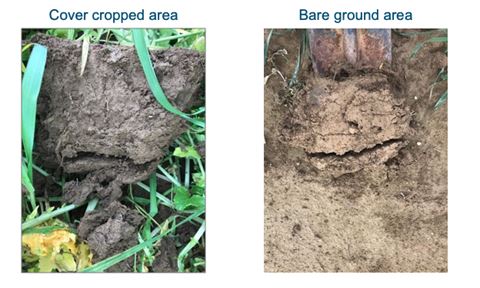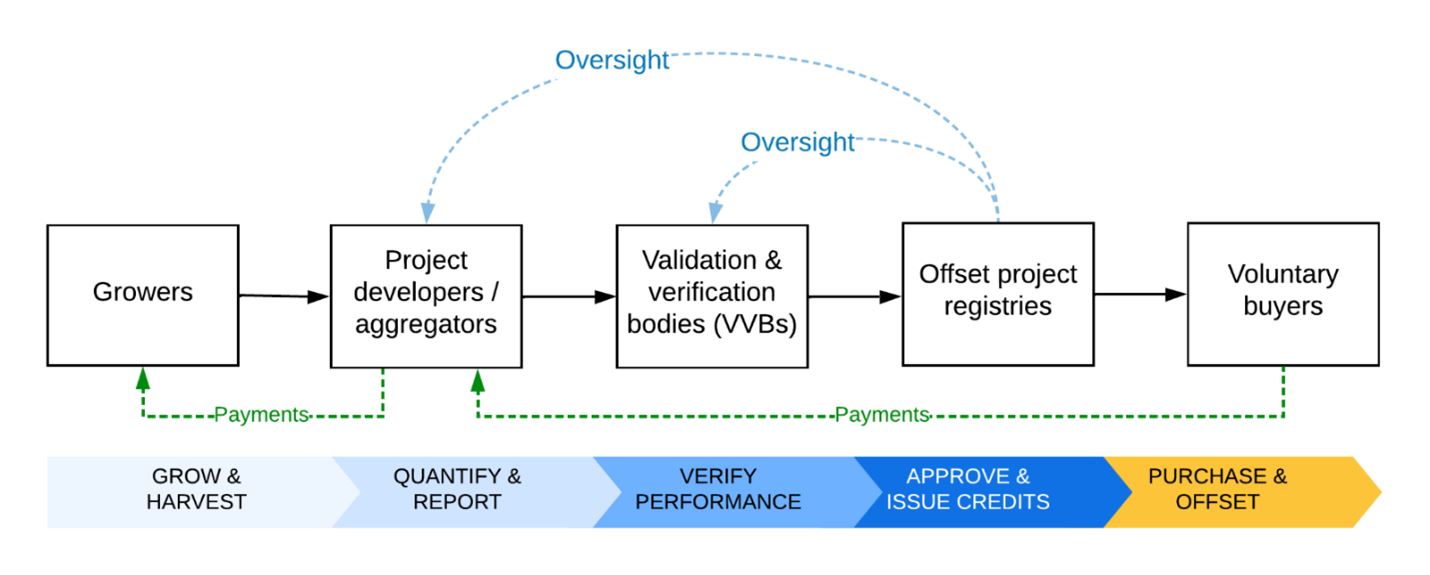Agriculture is essential to ensuring global food security. However, the agricultural industry is also one of the largest sources of greenhouse gas emissions. Some agricultural practices can release carbon dioxide, nitrous oxide and methane into the atmosphere. Incentivizing climate-smart farming practices by creating “soil carbon credits” is one way to reduce the impact of agriculture on the environment.
Carbon can be stored in soil in many ways. One very important type of soil carbon is organic matter, which is made of decayed materials from living things like plants, animals and microbes.
With a soil carbon credit system, carbon becomes a valued commodity for growers to gain additional revenue. One soil carbon credit represents 1 metric ton of carbon dioxide or an equivalent greenhouse gas emission that has been reduced, avoided, or removed from the atmosphere.

Research has shown that farm fields that use cover crops between harvest and planting store more carbon. On the left, the soil is darker, indicating more organic matter (carbon) in the soil. On the right, soil that was not covered, and it is lighter due to less carbon in the soil. Provided by Indigo Ag
Soil carbon credits are produced through carbon farming – using best practices that are known to hold carbon in the soils. Other practices that may receive credits might reduce nitrous oxide emissions. The practices vary by field but may include reduced tillage or no till, adding cover crops, rotational grazing, diversifying crop rotations, and reduced fertilizer usage.
The new additional practices slow the rate in which carbon is released into the atmosphere and increase the storage of organic carbon in the soil. In a sense, carbon becomes a new crop.
Growers “harvest” this crop through the collection and submission of data and records. They sell them to a new type of market, the carbon market.
To ensure that the soil carbon credits are high-quality and that the practices that generate them are environmentally beneficial, the credits must undertake a thorough vetting process. A project developer brings growers together and conducts all data collection and reporting. The project is then brought to a registry, which has established a set of standards for soil carbon projects.
There are even third-party verifiers who ensure the data, methods, and results are accurate. They check that the results adhere to the registry’s standards. Once verified, the registry approves the project results and issues carbon credits that can be sold on a carbon market. Then, other companies, such as a manufacturer, can buy these credits to offset their carbon footprint.

Soil carbon markets allow farmers to use best practices and in return earn additional income through “carbon farming.” Registries, like a bank, certify the process, and then the soil carbon credits can be sold to outside buyers to offset their greenhouse gas emissions. Provided by Indigo Ag
Not all credits are created equal. One of the loudest criticisms of carbon credits is that they allow companies the ability to “greenwash.” This means a company can make a claim they are helping the environment, without making any real impact. However, there are many safeguards that have been established.
These safeguards are continuously being improved upon by scientists, academics, and industry experts to ensure that when a carbon credit is produced, sold and eventually retired, that the credit is real and will not be reversed. It is also crucial that the credits are only issued for new practices, which result in carbon benefits that would not have otherwise occurred.
Soil carbon credits do more than just represent one metric ton of carbon dioxide. They offer several co-benefits to the communities from which they are generated. Carbon becomes a valued commodity for growers to gain additional revenue.
Ensuring an open and transparent voluntary market for credits to be sold has steadily increased the value of carbon credits, which means more value for the growers. But fiscal value is not only added through the selling of credits; in the long term, growers who participate end up with healthier soils, increased yields, and reduced inputs. Ensuring healthier soils also means that food security is established as additional yields meet the increase in demand. This is the environmental benefit of the soil carbon credit system.
Ultimately, soil carbon credits are an important tool that could be used in conjunction with other environmental practices to reduce our greenhouse emissions, while also benefiting and improving the lives and communities of those involved in generating them. As long as we need food, agriculture will exist; why not ensure that it is done in the most sustainable way possible?
Explore more on our webpage About Soils.